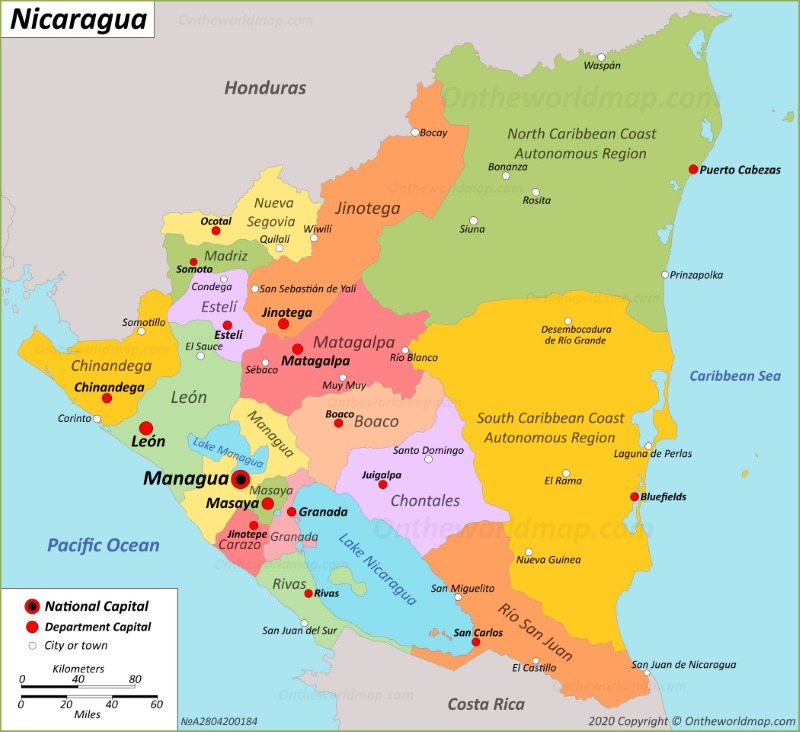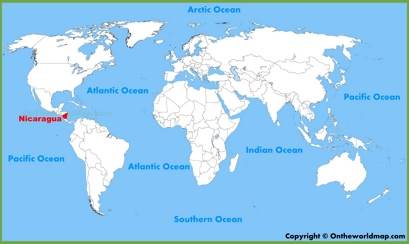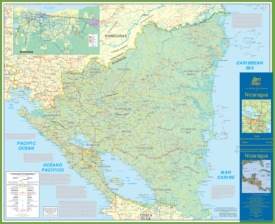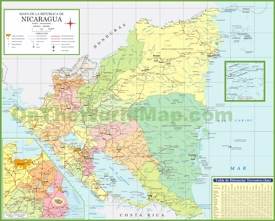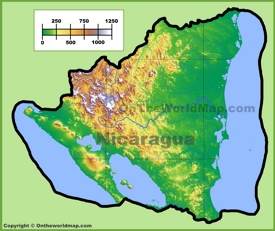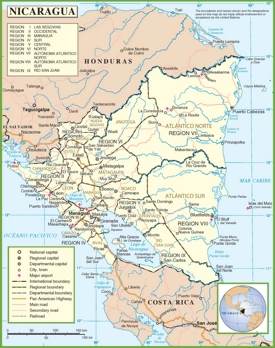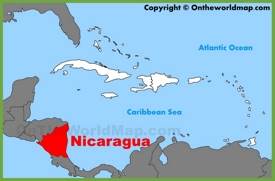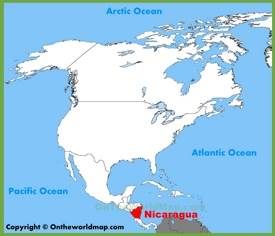Nicaragua Map
Description:
This map shows governmental boundaries of countries; lakes, departments, department capital cities, and major cities and towns in Nicaragua.
You may download, print or use the above map for educational, personal and non-commercial purposes. Attribution is required. For any website, blog, scientific research or e-book, you must place a hyperlink (to this page) with an attribution next to the image used.
Online Map of Nicaragua
About Nicaragua
Nicaragua, officially the Republic of Nicaragua, occupies a strategic location in Central America between Honduras to the north and Costa Rica to the south. The Caribbean Sea borders the country to the east, while the Pacific Ocean lies to the west. With an area of 50,338 square miles (130,375 square kilometers), Nicaragua ranks as the largest country in Central America.
The country's population reaches approximately 6.35 million people (2023 estimate), with about one-quarter living in the capital city of Managua. Other major urban centers include León, Granada, and Masaya. Spanish serves as the official language, though some indigenous communities speak native languages.
Nicaragua's economy relies primarily on agriculture, with coffee, bananas, sugarcane, and tobacco as major exports. The manufacturing sector produces textiles and footwear, while mining operations extract gold and silver. Despite abundant natural resources, Nicaragua remains one of the poorest countries in the Western Hemisphere, with significant income inequality and unemployment challenges.
The country's geography features diverse landscapes, including volcanoes, lakes, and tropical rainforests. Lake Nicaragua, the largest freshwater lake in Central America, contains unique freshwater sharks and hosts Ometepe Island, formed by two volcanoes. The Pacific region includes a chain of 40 volcanoes, with seven remaining active.
Tourism contributes significantly to Nicaragua's economy, attracting visitors to its colonial cities, beaches, and natural attractions. Granada, founded in 1524, draws tourists with its Spanish colonial architecture and colorful buildings. The surf beaches of San Juan del Sur attract water sports enthusiasts, while the Corn Islands in the Caribbean offer pristine beaches and excellent diving opportunities. Visitors explore the Masaya Volcano National Park to witness active lava flows and volcanic activity.
The country experiences a tropical climate with distinct wet and dry seasons. The Pacific lowlands receive less rainfall than the Caribbean region, which features extensive rainforests. Nicaragua faces environmental challenges, including deforestation, soil erosion, and water pollution, though conservation efforts protect several biosphere reserves and national parks.
The Facts:| Flag: |

|
| Capital: | Managua |
| Area: | 50,338 sq mi (130,375 sq km) |
| Population: | ~ 6,359,689 (2023 estimate)[1] |
| Official language: | Spanish |
| Religion: |
|
| Ethnic groups: |
|
| Currency: | Spanish |
| Driving side: | Right |
| Calling code: | +505 |
| Internet TLD: | .ni |
| Time zone: | UTC−6 (CST) |
| Gross domestic product (PPP) (2024 estimate): |
|
| Gross domestic product (nominal) (2024 estimate): |
|
| Official tourism website: | www.visitanicaragua.com |
Google Map of Nicaragua
List of Largest Cities in Nicaragua
- Chinandega (135,154)
- Jinotega (133,705)
- Granada (127,892)
- Estelí (126,290)
- Puerto Cabezas (113,534)
Departments of Nicaragua
| Department | Capital | Area | Population |
|---|---|---|---|
| Boaco | Boaco | 1,613 sq mi (4,177 sq km) | 188,809 |
| Carazo | Jinotepe | 417 sq mi (1,081 sq km) | 200,894 |
| Chinandega | Chinandega | 1,862 sq mi (4,822 sq km) | 445,784 |
| Chontales | Juigalpa | 2,502 sq mi (6,481 sq km) | 193,827 |
| Estelí | Estelí | 861 sq mi (2,230 sq km) | 233,077 |
| Granada | Granada | 402 sq mi (1,040 sq km) | 219,244 |
| Jinotega | Jinotega | 3,561 sq mi (9,222 sq km) | 499,289 |
| León | León | 1,984 sq mi (5,138 sq km) | 426,85 |
| Madriz | Somoto | 659 sq mi (1,708 sq km) | 181,328 |
| Managua | Managua | 1,338 sq mi (3,465 sq km) | 1,585,801 |
| Masaya | Masaya | 236 sq mi (611 sq km) | 409,265 |
| Matagalpa | Matagalpa | 2,627 sq mi (6,804 sq km) | 613,262 |
| Nueva Segovia | Ocotal | 1,348 sq mi (3,491 sq km) | 282,800 |
| Rivas | Rivas | 835 sq mi (2,162 sq km) | 185,514 |
| Río San Juan | San Carlos | 2,912 sq mi (7,541 sq km) | 140,786 |
Autonomous regions of Nicaragua
| Autonomous region | Capital | Area | Population |
|---|---|---|---|
| North Caribbean Coast Autonomous Region | Bilwi | 12,782 sq mi (33,106 sq km) | 563,088 |
| South Caribbean Coast Autonomous Region | Bluefields | 10,525 sq mi (27,260 sq km) | 434,270 |
Geography of Nicaragua
Nicaragua, the largest country in Central America, occupies 50,338 square miles (130,375 square kilometers) between Honduras to the north and Costa Rica to the south. The country borders the Caribbean Sea to the east and the Pacific Ocean to the west, providing 910 kilometers of coastline.
The country's topography divides into three distinct geographical regions: the Pacific lowlands, the Central highlands, and the Caribbean lowlands. The Pacific region features a chain of active volcanoes, including Concepción and San Cristóbal, and contains two major freshwater lakes: Lake Nicaragua (Cocibolca) and Lake Managua (Xolotlán). These lakes form part of a significant geological rift that runs through the country's center.
Nicaragua experiences a tropical climate with two distinct seasons: the dry season (December to April) and the rainy season (May to November). Average temperatures range from 21°C to 29°C, with the Pacific lowlands experiencing higher temperatures than the Central highlands. The Caribbean coast receives significantly more rainfall, averaging 2,500-6,500mm annually, while the Pacific region typically receives 1,000-2,000mm.
The Central highlands contain the country's most productive agricultural regions, with elevations ranging from 600 to 2,100 meters above sea level. The eastern Caribbean lowlands encompass approximately 50% of the national territory and consist primarily of tropical rainforest and pine savannas. This region includes the Mosquito Coast, characterized by extensive wetlands and lagoons.
Natural resources include gold, silver, copper, tungsten, lead, zinc, timber, and fish. The country's location makes it vulnerable to natural hazards, including earthquakes, volcanic eruptions, landslides, and hurricanes, particularly along the Caribbean coast.
Islands of Nicaragua
- Calala Island
- Corn Islands
- Cayos Miskitos
- Pearl Cays
- Rama Cay
- Ometepe Island
- Solentiname Islands
- Islets of Granada
- Zapatera Island
- Island of Maracon
- Island San Fernado
- Island Maracarronicta
- El Carmen Island
- Santa Rosa Island
- Island Colorada
- Island de San Anderes
- Island Muncos
- Island Puerto del Bluff
- Venado Island
Major Rivers of Nicaragua
- Río Coco - 485 mi (780 km)
- Río San Juan - 124 mi (200 km)
- Río Grande de Matagalpa - 298 mi (480 km)
- Río Escondido - 143 mi (230 km)
- Río Prinzapolka - 137 mi (220 km)
- Río Wawa - 124 mi (200 km)
- Río Kukalaya - 115 mi (185 km)
- Río Bambana - 112 mi (180 km)
- Río Tuma - 110 mi (177 km)
- Río Mico - 106 mi (170 km)
- Río Siquia - 93 mi (150 km)
- Río Rama - 87 mi (140 km)
- Río Kurinwás - 81 mi (130 km)
- Río Ulang - 75 mi (120 km)
- Río Viejo - 68 mi (110 km)
- Río Bocay - 62 mi (100 km)
- Río Wangki - 59 mi (95 km)
- Río Punta Gorda - 56 mi (90 km)
- Río Indio - 53 mi (85 km)
- Río Ochomogo - 50 mi (80 km)
Lakes of Nicaragua
- Lake Nicaragua - 3,191 sq mi (8,264 km2)
- Lake Managua - 400 sq mi (1,042 km2)
- Laguna de Perlas - 218 sq mi (564 km2)
- Bismuna Lagoon - 47 sq mi (122 km2)
- Pahara Lagoon - 31 sq mi (80 km2)
- Wounta Lagoon - 28 sq mi (73 km2)
- Karata Lagoon - 19 sq mi (49 km2)
- Laguna de Apoyo - 8.3 sq mi (21.5 km2)
Brief History of Nicaragua
Nicaragua's history began with indigenous settlements, primarily the Nicarao people, who inhabited the region before Spanish colonization. In 1522, Spanish conquistador Gil González Dávila initiated European contact with Nicaragua, leading to subsequent colonization under the Spanish Empire.
The colonial period lasted until 1821 when Nicaragua gained independence from Spain. The country then briefly joined the First Mexican Empire before becoming part of the Federal Republic of Central America in 1823. Nicaragua emerged as an independent nation in 1838, marking the beginning of a complex political period characterized by rivalry between the Liberal and Conservative factions.
The 20th century brought significant changes to Nicaragua. The United States occupied the country from 1912 to 1933, during which time the Somoza family established its authoritarian dynasty. The Somoza regime ruled Nicaragua from 1936 to 1979, when the Sandinista National Liberation Front (FSLN) overthrew the government in a popular revolution. This led to the Contra War (1981-1990), a period of civil conflict involving US-backed opposition forces.
Following the 1990 election of Violeta Chamorro, Nicaragua transitioned to a democratic system. The country has since experienced periods of economic reform, political tension, and social development. Modern Nicaragua continues to address challenges related to poverty, political polarization, and economic inequality while maintaining its position as Central America's largest nation by land area.
References
1. ^ Nicaragua. The World Factbook. Central Intelligence Agency. www.cia.govMaps of Nicaragua
Cities of Nicaragua
Islands of Nicaragua

